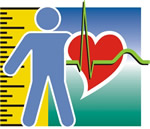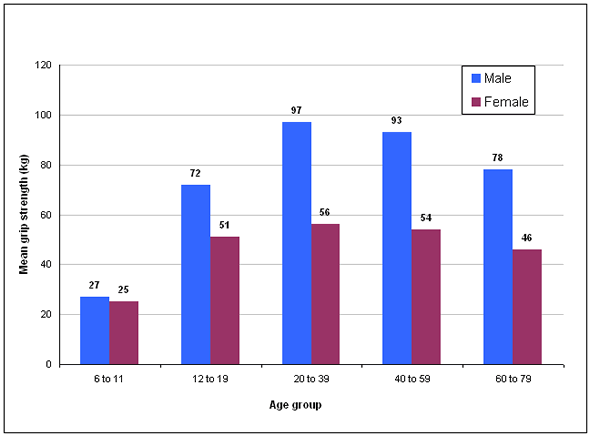Musculoskeletal fitness in Canada 2007 to 2009
Archived Content
Information identified as archived is provided for reference, research or recordkeeping purposes. It is not subject to the Government of Canada Web Standards and has not been altered or updated since it was archived. Please "contact us" to request a format other than those available.

About musculoskeletal fitness
The Canadian Health Measures Survey measured musculoskeletal fitness of Canadians aged 6 to 79 with three physical measures tests:
- muscular strength , which is demonstrated by measures of grip strength
- flexibility , demonstrated by the distance achieved in the sit and reach test
- muscular endurance , demonstrated by the number of completed partial curl-ups in one minute.
Musculoskeletal fitness has been associated with many health benefits including increased mobility and functionality, decreased risk of osteoporosis, improved resting blood pressure, improved insulin response and glucose uptake, decreased risk factors associated with cardiovascular disease, and decreased mortality.
Muscular strength generally increases from early childhood to early adulthood and then declines in middle and late adulthood. Among those aged 20 to 39, mean muscular strength is 97 kg for males and 56 kg for females. The average muscular strength for males aged 6 to 79 is 84 kg, and for females, it is 51 kg.
Chart 1
Muscular strength, measured by grip strength

Source: Canadian Health Measures Survey, 2007 to 2009
Flexibility
In all age groups, females consistently demonstrate greater flexibility than males and this difference is more pronounced in late adulthood.
Chart 2
Average flexibility on sit and reach test

Source: Canadian Health Measures Survey, 2007 to 2009
The average distance achieved on the sit and reach test for females is 29.3 cm and for males 23.9 cm. Flexibility remains relatively constant for females until middle age, and then gently declines among older age groups. For males, flexibility dips among those aged 12 to 19, and the largest decline in average flexibility is seen among males aged 60 to 69.
Muscular endurance
Over one-third of women aged 20 to 39 and the majority of those aged 40 or older were unable to complete even one partial curl-up. Less than a third (31%) of women aged 20 to 39 completed the full 25 curl-ups, and at ages 60 to 69, the percentage was 4%.
More men completed the full 25 curl-ups: 55% of men aged 20 to 39 and 11% of men aged 60 to 69.
More detailed analyses on the fitness of the nation including changes over time are available in the studies, "Fitness of Canadian adults: Results from the 2007-2009 Canadian Health Measures Survey" and "Fitness of Canadian children and youth: Results from the 2007-2009 Canadian Health Measures Survey," in Health Reports, Vol. 21, no. 1.
- Date modified:
